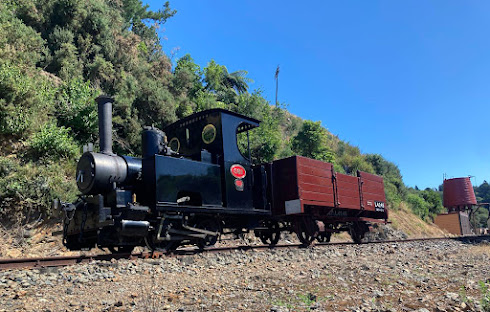Saturday, September 30, 2023
tiny NZ Public Works Department 0-4-0T from 1921
Friday, September 29, 2023
1937 Singer Sports car
the little FSO/FSM Syrena of Poland
"The Syrena was produced in various models: 100, 101, 102, 103, 104, while the most popular model was the 105 [below]. All were two-door sedans with two-stroke engines, initially of two cylinders. In 1965 the Syrena received a larger three-cylinder engine.
"From 1968 a prototype model named laminat was produced. A van called Syrena Bosto and a pick-up called the R20 were also produced. A coupé Syrena Sport and a hatchback Syrena 110 (in 1966) remained prototypes only.
"A Siren is a mermaid who, according to the legend, protects the river Wisła and the Polish capital city, Warsaw. She is featured on the city's coat of arms. A diminutive name Syrenka (little siren) is commonly used for the car in Poland."
Thursday, September 28, 2023
Chevrolet truck converted to run on methane gas, Sydney, 1942
Wednesday, September 27, 2023
Monday, September 25, 2023
Cab ride: Šargan Eight -- Mokra Gora - Šargan Vitasi - Mokra Gora
Sunday, September 24, 2023
meeting of eastbound and westbound Western Star trains in Montana, 1950s
A Great Northern railway publicity photo of the eastbound and westbound Western Star passenger trains meeting at Whitefish Lake, Montana. Like other American long distance passenger trains the services lasted until the advent of Amtrak in 1971.
Saturday, September 23, 2023
North Shore Steam Ferry Company terminal, Sydney, pre-WW1
Below is an earlier pic with sandstone rocks that aren't in the above photo.
Kirribilli -- what is still the Jeffery Street wharf?
Friday, September 22, 2023
double deck buses at Manly Wharf, Sydney, 1940s
vehicles on Hay Street, Perth, WA 1936
Including a tram, a little Austin car immediately in front. The Town Hall is the tower in the background.
Sydney R class tram in George Street, mid-1950s
Wednesday, September 20, 2023
Tuesday, September 19, 2023
1972-1980 Polish Fiat 126
The Fiat 126 (Type 126) is a four-passenger, rear-engine, city car manufactured and marketed by Fiat over a twenty-eight year production run from 1972 until 2000, over a single generation. Introduced by Fiat in October 1972 at the Turin Auto Show,[1] the 126 replaced the Fiat 500, using major elements from its design. A subsequent iteration, marketed as the 126 Bis, used a horizontally oriented, water-cooled engine and featured a rear hatchback.
The majority of 126s (some 3.3 million) were manufactured in Tychy and Bielsko-Biała plants, Poland and were marketed as the Polski Fiat 126p in many markets. Fiat stopped marketing the 126 in 1993 in favor of its new front-engined Cinquecento. Total production reached approximately 4.7 million units.
In Poland, the car became a people's car,[3] and a cultural icon, earning the nickname Maluch, meaning "The Little One" or "Toddler",[4][5] a name that eventually became official in 1997, when 'Maluch' started appearing, badged on the rear of the car.
In early 2020, the 28-year production run of the Fiat 126 was counted as the twenty-sixth most long-lived single generation car in history by Autocar magazine."[3]
Sunday, September 17, 2023
el coche motor Brill 60 from the 1930s of the AFE, Uruguay
Some info--
The body of the Brill 60 was completely differentand presented a much lighter and more refined car. The oval-shaped cabin had a slight forward inclination as did the rear end of the car. The windshield of the cabin was divided into 3 sectors and the rear end into six sectors, forming a panoramic window that allowed observing the landscape. Its cabin was spacious and had a compartment for parcels and luggage, and the driving controls were located on the left. It was entered through two sliding doors located on both sides of the vehicle, which were also used to enter luggage into the loading area. Above the cab was a powerful 110-watt headlight that provided great forward illumination at night.
The entrance platform to the saloon was located in the center of the car, with access on both sides and closed by double-leaf folding doors on each side. The first class compartment was located in front of the access platform, having an independent toilet cabinet and lavatory. The seats in this compartment were very comfortable and upholstered in leather.
The second class compartment was located behind the access platform, and had a separate toilet cabinet as well.
NZ Post Office logo 1940s
It shows what looks to be a 1930s Douglas or maybe Lockheed aircraft, a streamlined J locomotive from 1939 and a ship as well as a broadcast tower. The wings were perhaps a suggestion that airmail is now de rigueur.
historic tram in Bochum, Germany
The long overhang on the short wheelbase would have enabled this 1948 built tramcar with 2 powered axles to negotiate some tight curves. More info and pics
The tram system around Bochum grew to impressive proportions during the 20th century and remains so at 86 km route length and connects Bochum with Gelsenkirchen, Hattingen, Herne and Witten.
Saturday, September 16, 2023
Ontario and Western Railroad train at Liberty, New York, circa 1910
The New York, Ontario and Western Railroad (OW), was a regional railway which had its origins in 1868 and lasted until 1957, see earlier posts. The road number of the loco is 140.
London Transport trolleybus art
Maybe an early post-WW2 Morris is depicted in the background. See earlier posts. Painting by Alan Spillet.
Friday, September 15, 2023
Thursday, September 14, 2023
DSB Bcm class sleeping car, 1990s era, model
You may wonder if any trips within Denmark were long enough to justify sleeping cars even over the Storbelt before the bridge was built, but of course they could go to international destinations too. (Lima model?)

















































